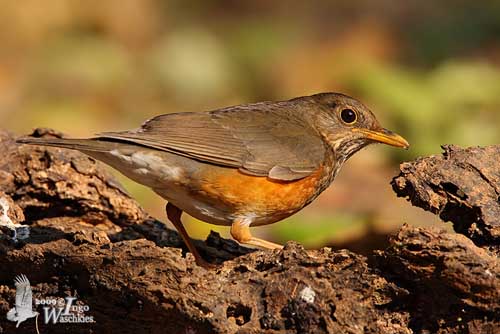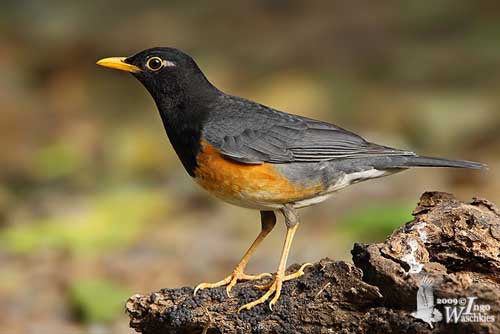
DIET:
The Black-breasted Thrush forages actively on the ground where it captures insects, snails, slugs and other invertebrates. It usually forages alone, but several birds may gather at fruiting trees.
It also consumes berries and ripe figs.
PROTECTION / THREATS / STATUS:
The Black-breasted Thrush was formerly threatened by habitat loss. It is scarce in India, but the species is now fairly common in most of range. It has wide range, and in spite of habitat destruction which remains the main threat, the populations are not currently threatened.
Fr: Merle à poitrine noire
All : Schwarzbrustdrossel
Esp: Zorzal Pechinegro
Ital : Tordo pettonero
Nd: Zwartborstlijster
Sd: Svartbröstad trast
Photographer:
Ingo Waschkies
Bird Photography
Text by Nicole Bouglouan
Sources:
HANDBOOK OF THE BIRDS OF THE WORLD Vol 10 by Josep del Hoyo-Andrew Elliott-David Christie - Lynx Edicions - ISBN: 8487334725
A Field Guide to the Birds of South-East Asia by Craig Robson. New Holland Publishers. ISBN: 9781780090498
THRUSHES by Peter Clement and Ren Hathway – HELM - ISBN: 0713639407
BirdLife International (BirdLife International)
XENO-CANTO – Sharing Birds sounds from around the world
Toronto Zoo – Same planet. Different world.
Black-breasted Thrush
Turdus dissimilis
Passeriforme Order – Turdidae Family
BIOMETRICS:
Length: 22-23,5 cm
DESCRIPTION:
The Black-breasted Thrush is a forest bird, rarely seen in the open. Monotypic.
The adult male has black head, nape and breast.
The upperparts, including wings and tail, are slaty grey.
On the underparts, belly and flanks are bright orange, whereas lower belly and vent are white.
Bill, eye-ring, legs and feet are orange-yellow. The eyes are dark brown. We can see a small bare area behind the eye, more or less visible.

The adult female has dark olive-brown head and upperparts, buffy-white submoustachial stripe and throat, and blackish-brown malar stripe.
On the underparts, the whitish breast is conspicuously spotted dark brown. Rest of underparts is as male.
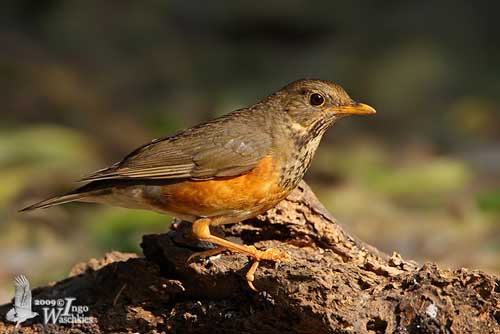
The juvenile resembles female with fine spots and streaks on head to scapulars. We can see an orange double wing bar formed by two rows of spots.
On the underparts, the spotting extends from breast to pale orange flanks.
The bare parts are duller.
VOICE: SOUNDS BY XENO-CANTO
The Black-breasted Thrush’s call is a resounding “tup-tup tup-tup-tup-tup…” often repeated. The alarm call is similar but harsher, ending in slurred “tock”.
The song is melodious, a sweet, mellow series of short, unhurried phrases of 3-8 notes “tew-tew weet… tew-tew-tiwi… piuu-piuu-piuu… wirriwiwu iih… ». This song is often delivered for several hours.
HABITAT:
The Black-breasted Thrush occurs in tropical and subtropical regions. It breeds in moist or damp evergreen woods and forests with thick undergrowth layer.
According to the range, it may frequent open pine woods with little undergrowth, scrub and secondary growth.
This species can be seen between 1200 and 2500 metres of elevation. It winters from sea-level to 400 metres, in scrub-jungle and mangroves.
RANGE:
The Black-breasted Thrush is found in NE India, Myanmar, S China, Pakistan, Thailand and Vietnam.
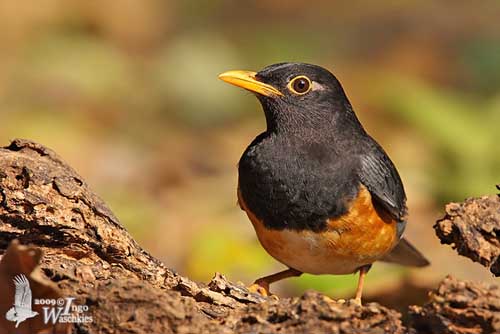
BEHAVIOUR:
The Black-breasted Thrush forages mainly on the ground where it captures insects and molluscs. Small groups may gather at fruiting trees too.
It searches for food beneath trees and shrubs, and turns over the leaves like the Common Blackbird. It is always active and usually solitary when feeding on the ground. Its favourite preys are insects, snails and slugs, and other invertebrates. It also consumes berries and ripe figs.
The displays are unknown, but as in all species with sexual dimorphism, the male probably enhances and exposes the bright orange underparts by several upright postures in front of the female.
The same type of displays is also used in territory defence.
The Black-breasted Thrush is resident in its range, but seasonal altitudinal movements occur in winter, and also some longer distance migrations are observed.
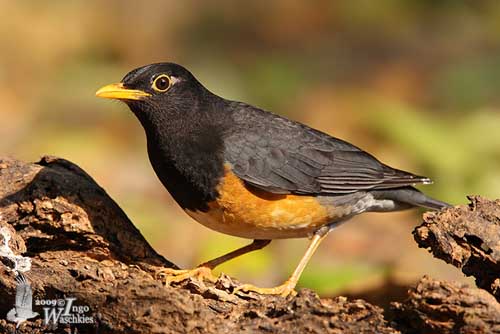
FLIGHT:
The Black-breasted Thrush has undulating flight, and is very agile on the ground where it hops and runs.
REPRODUCTION:
The breeding season varies with the range, from April-July in India, April-June in Myanmar, to May-June in China.
The Black-breasted Thrush’s nest is usually placed in fork in small tree or shrub, but it may occasionally be found on the ground, and even in a hole in bank. This is a sturdy cup-shaped structure made with green moss and plant fibres. It is placed between one and six metres above the ground.
The female lays 3-4 eggs. They may be buff, pale green or greenish-blue with dark markings. The incubation lasts about 12-14 days.
